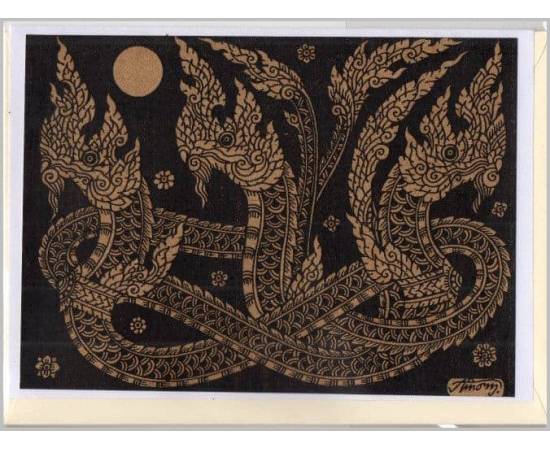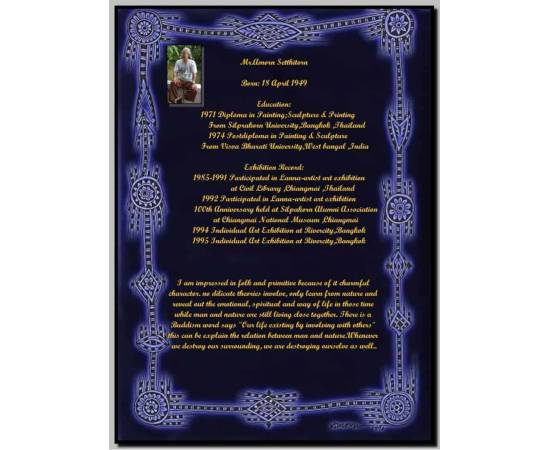Thai traditional art Naga by printing on Sepia paper card.
Please sign in so that we can notify you about a reply
The new art Naga.
Handmade with a Naga design on paper.
Then remove the Naga design and then put into a sepia paper cards. By printing .
Size: Length 17.5 cm, width 12.5 cm
For a message to your loved ones.
Or your friends or people you know.
For those who can get this card would be nice.
When you see the artwork on the card.
In one piece free of envelope for the card.
Nāga (IAST: nāgá}}, IPA: [nəɡá] is the Sanskrit and Pāli word for a deity or class of entity or being, taking the form of a very great snake, Sea serpent — specifically the king cobra, found in Hinduism and Buddhism. A female nāga is a nāgī or nāginī.
Traditions about nāgas are also very common in all the Buddhist countries of Asia. In many countries, the nāga concept has been merged with local traditions of great and wise serpentsor dragons. In Tibet, the nāga was equated with the klu, wits that dwell in lakes or underground streams and guard treasure. In China, the nāga was equated with the lóng orChinese dragon.
The Buddhist nāga generally has the form of a great cobra-like snake, usually with a single head but sometimes with many. At least some of the nāgas are capable of using magic powers to transform themselves into a human semblance. In Buddhist painting, the nāga is sometimes portrayed as a human being with a snake or dragon extending over his head. One nāga, in human form, attempted to become a monk; when telling it that such ordination was impossible, the Buddha told it how to ensure that it would be reborn a man, able to become a monk.[11]
In the 'Devadatta' chapter of the Lotus Sutra, an eight year old female Naga, after listening toManjushri preach the Lotus Sutra, transforms her body into that of a male human and immediately reaches full enlightenment.[12] This tale appears to reinforce the viewpoint prevalent in Mahayana scriptures that a male human body is required for Buddhahood, even if a being is so advanced in her realization that she can magically transform her body at will and demonstrate the emptiness of the physical form itself.
Nāgas are believed to both live on Mount Sumeru, among the other minor deities, and in various parts of the human-inhabited earth. Some of them are water-dwellers, living in streams or the mer; others are earth-dwellers, living in underground caverns.
The nāgas are the servants of Virūpākṣa (Pāli: Virūpakkha), one of the Four Heavenly Kings who guards the western direction. They act as a guard upon Mount Sumeru, protecting the devas of Trāyastriṃśa from attack by the Asuras.
Among the notable nāgas of Buddhist tradition is Mucalinda, protector of the Buddha. In the Vinaya Sutra (I, 3) the Buddha shortly after his enlightenment is meditating in a forest when a great storm arises, but graciously Naga King Mucalinda gives shelter to the Buddha from the storm by covering the Buddha's head with his 7 snake heads.[13] Then the king takes the form of a young Brahmin and renders the Buddha homage.[14]
It is noteworthy that the 2 chief disciples of the Buddha, Sariputra and Maudgalyayana are referred to as Mahanaga.[15] Some of the most important figures in Buddhist history symbolize nagas in their names such as Dignaga, Nagasena, and, although other etymons are assigned to his name, Nagarjuna.
In the Vajrayana and Mahasiddha traditions according to Beer (1999),[page needed] many notable fully enlightened nagas also transmitted and/or transported terma into and out of the human realm that had been elementally encoded by adepts.
Norbu (1999: p.?) states that according to tradition the Prajnaparamita terma teachings are held to have been conferred upon Nagarjuna by Nagaraja, the King of the nagas, who had been guarding them at the bottom of a lake. Refer Lotus Sutra.
Payment
I accept only PayPal payments Payment is expected within 7 days after the auction ends.
Shipping and handling
Shipping and handling worldwide. The package will be shipped directly from Thailand Post via air mail 3-4 weeks Standard Time. (By registered mail).
Return policy.
100% Satisfaction Guarantee If you are not satisfied with the product you purchased for any reason, please contact us for a return instruction within 7 days for a refund. Shipping and handling costs are not refundable. Return shipping will be paid by the buyer.
Please contact us by Etsy message.
Thank you very much for visiting and have a nice day!!!
Handmade with a Naga design on paper.
Then remove the Naga design and then put into a sepia paper cards. By printing .
Size: Length 17.5 cm, width 12.5 cm
For a message to your loved ones.
Or your friends or people you know.
For those who can get this card would be nice.
When you see the artwork on the card.
In one piece free of envelope for the card.
Nāga (IAST: nāgá}}, IPA: [nəɡá] is the Sanskrit and Pāli word for a deity or class of entity or being, taking the form of a very great snake, Sea serpent — specifically the king cobra, found in Hinduism and Buddhism. A female nāga is a nāgī or nāginī.
Traditions about nāgas are also very common in all the Buddhist countries of Asia. In many countries, the nāga concept has been merged with local traditions of great and wise serpentsor dragons. In Tibet, the nāga was equated with the klu, wits that dwell in lakes or underground streams and guard treasure. In China, the nāga was equated with the lóng orChinese dragon.
The Buddhist nāga generally has the form of a great cobra-like snake, usually with a single head but sometimes with many. At least some of the nāgas are capable of using magic powers to transform themselves into a human semblance. In Buddhist painting, the nāga is sometimes portrayed as a human being with a snake or dragon extending over his head. One nāga, in human form, attempted to become a monk; when telling it that such ordination was impossible, the Buddha told it how to ensure that it would be reborn a man, able to become a monk.[11]
In the 'Devadatta' chapter of the Lotus Sutra, an eight year old female Naga, after listening toManjushri preach the Lotus Sutra, transforms her body into that of a male human and immediately reaches full enlightenment.[12] This tale appears to reinforce the viewpoint prevalent in Mahayana scriptures that a male human body is required for Buddhahood, even if a being is so advanced in her realization that she can magically transform her body at will and demonstrate the emptiness of the physical form itself.
Nāgas are believed to both live on Mount Sumeru, among the other minor deities, and in various parts of the human-inhabited earth. Some of them are water-dwellers, living in streams or the mer; others are earth-dwellers, living in underground caverns.
The nāgas are the servants of Virūpākṣa (Pāli: Virūpakkha), one of the Four Heavenly Kings who guards the western direction. They act as a guard upon Mount Sumeru, protecting the devas of Trāyastriṃśa from attack by the Asuras.
Among the notable nāgas of Buddhist tradition is Mucalinda, protector of the Buddha. In the Vinaya Sutra (I, 3) the Buddha shortly after his enlightenment is meditating in a forest when a great storm arises, but graciously Naga King Mucalinda gives shelter to the Buddha from the storm by covering the Buddha's head with his 7 snake heads.[13] Then the king takes the form of a young Brahmin and renders the Buddha homage.[14]
It is noteworthy that the 2 chief disciples of the Buddha, Sariputra and Maudgalyayana are referred to as Mahanaga.[15] Some of the most important figures in Buddhist history symbolize nagas in their names such as Dignaga, Nagasena, and, although other etymons are assigned to his name, Nagarjuna.
In the Vajrayana and Mahasiddha traditions according to Beer (1999),[page needed] many notable fully enlightened nagas also transmitted and/or transported terma into and out of the human realm that had been elementally encoded by adepts.
Norbu (1999: p.?) states that according to tradition the Prajnaparamita terma teachings are held to have been conferred upon Nagarjuna by Nagaraja, the King of the nagas, who had been guarding them at the bottom of a lake. Refer Lotus Sutra.
Payment
I accept only PayPal payments Payment is expected within 7 days after the auction ends.
Shipping and handling
Shipping and handling worldwide. The package will be shipped directly from Thailand Post via air mail 3-4 weeks Standard Time. (By registered mail).
Return policy.
100% Satisfaction Guarantee If you are not satisfied with the product you purchased for any reason, please contact us for a return instruction within 7 days for a refund. Shipping and handling costs are not refundable. Return shipping will be paid by the buyer.
Please contact us by Etsy message.
Thank you very much for visiting and have a nice day!!!
Country
Thailand
No reviews found





